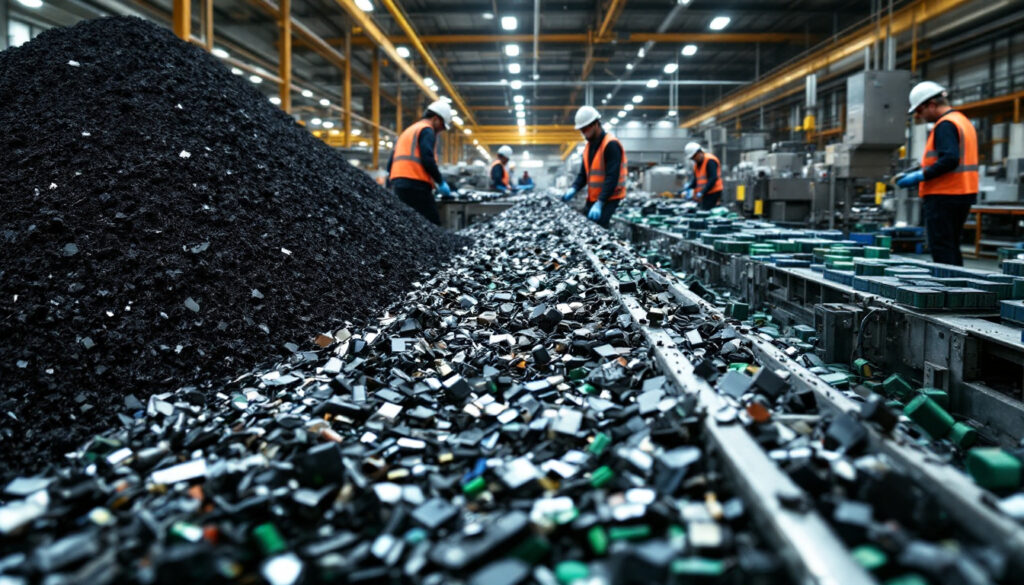China's Lithium-Ion Battery Recycling Industry: Market Leadership and Future Outlook
China maintains its dominant position in the global lithium-ion battery recycling sector through advanced technological capabilities, comprehensive infrastructure, and strategic policy frameworks. Despite challenges such as overcapacity and international trade tensions, the industry is poised for transformation under new national standards set to take effect in July 2025. These regulations aim to streamline black mass production, enhance quality control, and secure supply chains. Meanwhile, evolving battery chemistries, particularly the rise of lithium iron phosphate (LFP) batteries, are reshaping market dynamics, necessitating adaptive strategies from recyclers to maintain profitability amid shifting material values.
What Makes China the Global Leader in Lithium-Ion Battery Recycling?
Advanced Technological Capabilities
China's recycling industry accounts for over two-thirds of global black mass production and consumption, a dominance rooted in superior processing technologies and cost efficiencies. Domestic recyclers operate at significantly lower costs compared to international counterparts, with refining expenses approximately 30-40% cheaper due to scaled operations and integrated supply chains.
The country's focus on hydrometallurgical and pyrometallurgical advancements has enabled high recovery rates for critical metals like lithium (85-90%), nickel (92%), and cobalt (88%). These technologies are further supported by automation in battery disassembly, reducing labor costs and improving safety in handling end-of-life (EOL) batteries.
Comprehensive Recycling Infrastructure
Nationwide collection networks and vertically integrated facilities underpin China's lithium-ion battery recycling ecosystem. Over 1,200 registered collection points and 150+ large-scale processing plants ensure efficient feedstock aggregation, though current utilization rates remain suboptimal at 20-30% due to scrap shortages.
The infrastructure spans the entire value chain, from dismantling to material recovery, with regional hubs like Guangdong and Zhejiang specializing in LFP processing, while Jiangsu and Shandong focus on nickel-cobalt-manganese (NCM) chemistries. This geographic specialization aligns with localized EV production clusters, minimizing logistics costs and enabling closed-loop material flows with battery manufacturers.
How Will China's New National Standards Transform Battery Recycling?
Implementation of Unified Black Mass Standards
Scheduled for July 2025, China's first national black mass standards will establish uniform specifications for nickel, cobalt, lithium, and manganese content, legally enabling imports to address domestic scrap deficits. The standards mandate minimum purity thresholds: 95% for lithium carbonate equivalents in LFP black mass and 92% for combined nickel-cobalt yields in NCM variants.
By formalizing quality benchmarks, the policy aims to reduce informal recycling activities, which currently account for 25% of the market and often bypass environmental protocols. Import legalization is expected to increase black mass inflows by 150,000 tonnes annually by 2026, primarily from Southeast Asia and Europe.
Enhanced Quality Control Measures
Traceability systems under the new standards require QR code tracking for all black mass batches, linking them to original battery manufacturers and recycling facilities. Recyclers must now adhere to emissions limits of 50 mg/m³ for particulate matter and 98% wastewater reuse rates, enforced through real-time monitoring linked to provincial environmental bureaus.
These measures respond to international criticism over pollution from informal recyclers, whose unregulated operations have contributed to soil lead concentrations exceeding 500 mg/kg in some regions. Compliance costs are projected to rise by 15-20%, potentially consolidating the industry among larger players with existing environmental management systems.
What Challenges Is China's Battery Recycling Industry Facing?
Overcapacity and Utilization Issues
Despite 300,000 tonnes of annual recycling capacity, the industry faces a 70% utilization gap due to insufficient EOL battery supply. EV batteries' extended lifespans—averaging 8-10 years versus initial estimates of 6-8 years—delay feedstock availability, exacerbating scrap shortages.
This mismatch has intensified competition, with NCM scrap prices reaching 23,000-25,000 yuan/tonne, while LFP variants trade at 7,000-8,300 yuan/tonne, reflecting their lower metal value. Over 50% of recyclers reportedly operate at negative margins, relying on government subsidies covering 30-40% of operational costs.
Trade and Tariff Pressures
Recent U.S. tariffs of 25% on Chinese EVs and reciprocal duties of 30% on lithium imports have disrupted trans-Pacific trade flows, redirecting 40% of China's battery exports to the EU. However, potential EU tariffs of 15-20% under anti-subsidy investigations threaten this pivot, risking a 15 million-tonne oversupply of lithium carbonate domestically by 2026.
Market sentiment has turned bearish, with NCM black mass payables dropping to 72-75% of metal salt prices, down 5 percentage points year-on-year. This uncertainty has led many market participants to adopt a wait-and-see approach, subduing trading activity.
How Are NCM and LFP Battery Chemistries Shaping the Recycling Market?
NCM Black Mass Market Dynamics
NCM black mass remains the premium feedstock, with payables at 72-75% DDP China for nickel, cobalt, and lithium. However, trading volumes have declined 30% month-on-month as buyers await clarity on U.S.-China tariff resolutions.
Cobalt recovery economics are particularly vulnerable, with prices dipping to $32,000/tonne, narrowing recyclers' margins to 8-12% compared to 15-18% in 2024. Despite these challenges, the higher intrinsic value of NCM batteries continues to make them the preferred recycling feedstock.
LFP Black Mass Growth Trajectory
LFP's share of global black mass supply is projected to rise from 22% to 31% by 2031, driven by its 60% cost advantage in EV applications. Current LFP black mass trades at 2,400-2,550 yuan per percentage point of lithium content, with typical yields of 2-3% lithium per tonne.
The chemistry's sensitivity to lithium carbonate prices—which fell to 70,000-71,000 yuan/tonne in April 2025—has increased margin volatility, compressing recycler profits to 5-7% compared to NCM's 8-12%. Despite these economic challenges, the growing market share of LFP batteries in China's EV fleet makes them an increasingly important recycling stream for strategic lithium investments.
What Are the Key Price Trends in China's Battery Recycling Market?
End-of-Life Battery Pricing
NCM EOL battery prices currently stand at 23,000-25,000 yuan per tonne, reflecting their higher content of valuable metals. In contrast, LFP EOL battery prices have declined to 7,000-8,300 yuan per tonne from previous levels of 7,500-8,600 yuan per tonne.
This significant price differential of approximately 200% between NCM and LFP scrap highlights the economic challenges in LFP recycling, where material recovery values are substantially lower. The price gap underscores why many recyclers prioritize securing NCM feedstock despite the growing prevalence of LFP batteries.
Raw Material Price Influences
Lithium carbonate price fluctuations directly impact recycling economics, particularly for LFP batteries. Recent prices of 70,000-71,000 yuan ($9,571-9,708) per tonne represent a decrease from previous highs, affecting the profitability of lithium recovery operations.
Declining prices for sulfur, a component in some recycling processes, also affect LFP recycling economics. These market dynamics create a challenging environment for recyclers, who must continuously adapt their processes and business models to maintain viability amidst volatile commodity prices and battery minerals demand outlook.
How Is Battery Scrap Supply Affecting the Recycling Industry?
Supply-Demand Imbalance
Battery scrap supply has become a "major concern" for both black mass producers and refiners throughout China. One key factor is that batteries are lasting longer than initially expected, contributing to significant supply shortages in the recycling pipeline.
Many recycling companies are operating at utilization rates as low as 20-30% due to these scrap shortages. This underutilization of expensive processing infrastructure is creating financial pressure across the industry, forcing some smaller operators to consolidate or exit the market entirely.
Competition for Feedstock
Competition for battery scrap in China has become "fierce," particularly for NCM battery scrap with its higher intrinsic material value. This competition has driven up acquisition costs, further squeezing already tight margins for recyclers.
There is a growing focus on the historically less-competitive but rapidly expanding LFP segment, as companies seek to secure future feedstock sources. Forward-thinking recyclers are developing specialized processes for LFP materials, anticipating the eventual wave of these batteries reaching end-of-life in the coming years.
What Is the Long-Term Outlook for China's Battery Recycling Industry?
Evolving Battery Chemistry Challenges
The decreasing intrinsic value of battery feedstock presents a significant challenge over the next decade. Modern cathode chemistries (LFP, LMFP, lower-cobalt NCM) pose economic challenges for recyclers due to their reduced content of high-value metals.
As Luke Sweeney, Senior Battery Recycling Analyst notes, "The lack of nickel and cobalt kills the economics of recycling LFP batteries." This fundamental challenge is forcing the industry to rethink its approach to material recovery and process economics as battery compositions continue to evolve. Additionally, digital transformation in mining is helping recyclers optimize their processes.
Market Adaptation Strategies
Leading firms are increasing their focus on process efficiency to maintain profitability despite decreasing feedstock values. Specialized recycling technologies for different battery chemistries are being developed to maximize recovery rates of even low-concentration materials.
Vertical integration strategies are becoming increasingly common as recyclers seek to secure feedstock supply. Partnerships with battery manufacturers and auto companies are creating closed-loop systems that ensure a steady flow of end-of-life batteries, while also providing recycled materials back to battery producers. These efforts align with ESG challenges in mining and decarbonisation in mining initiatives.
FAQ: China's Lithium-Ion Battery Recycling Industry
What is black mass in battery recycling?
Black mass is the crushed and processed material from spent lithium-ion batteries, containing valuable metals like lithium, cobalt, nickel, and manganese that can be recovered and reused in new batteries. It serves as the primary intermediate product in the battery recycling value chain.
How do NCM and LFP black mass differ?
NCM (nickel-cobalt-manganese) black mass contains higher-value metals including nickel and cobalt, making it more economically attractive to recycle. LFP (lithium iron phosphate) black mass primarily contains lithium and iron, with lower overall material value, presenting different economic and technical recovery challenges.
What factors influence black mass prices in China?
Black mass prices are primarily influenced by underlying metal prices (lithium, cobalt, nickel), scrap battery availability, processing costs, and market demand for recycled materials. International trade policies and environmental regulations also play significant roles in price formation.
How will China's new national standards affect the global recycling market?
The standards will likely formalize China's position as a global recycling hub, potentially opening the door to increased black mass imports. They will also raise quality standards for domestic recyclers, potentially leading to industry consolidation while improving the overall environmental performance of the sector.
Key Statistics: China's Battery Recycling Market
| Metric | Value | Context |
|---|---|---|
| China's share of global black mass capacity | >66% | Dominant global position in both production and consumption |
| Refiner utilization rates | 20-30% | Some facilities operating well below capacity due to scrap shortages |
| LFP black mass in global supply (2024) | 22% | Current market share of LFP chemistry in recycling |
| LFP black mass in global supply (2031 projection) | 31% | Expected growth due to increasing LFP battery adoption |
| NCM black mass payables | 72-75% | Percentage of metal salts prices for nickel, cobalt and lithium |
| LFP black mass price | 2,400-2,550 yuan per % Li | Current workable market level in China |
| Typical lithium content in Chinese LFP black mass | 2-3% | Standard material composition range |
| NCM EOL battery prices | 23,000-25,000 yuan/tonne | Current market price for end-of-life NCM batteries |
| LFP EOL battery prices | 7,000-8,300 yuan/tonne | Current market price for end-of-life LFP batteries |
Looking to Stay Ahead of Major Mining Discoveries?
Discovery Alert's proprietary Discovery IQ model delivers real-time notifications when significant mineral discoveries are announced on the ASX, giving investors a crucial market advantage. Explore how historic discoveries have generated exceptional returns by visiting the Discovery Alert discoveries page and position yourself to capitalise on the next major find.




